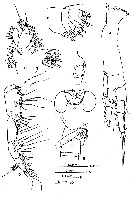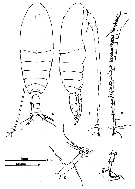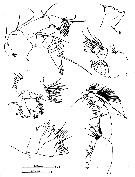|
|
 |
|
Calanoida ( Order ) |
|
|
|
Calanoidea ( Superfamily ) |
|
|
|
Calanidae ( Family ) |
|
|
|
Calanus ( Genus ) |
|
|
| |
Calanus agulhensis De Decker, Kaczmaruk & Marska, 1991 (F,M) | |
| | | | | | | Syn.: | Calanus finmarchicus : Cleve, 1904 a (p.185); ? Oliveira, 1945 (p.191); Senô & al., 1963 (p.53); De Decker, 1964 (p.7, 14, 18, 26, 31); 1968 (p.45); 1973 (218), 1984 (p.315, Rem.: 320, 331: carte); 1984 a (p.156); Carter, 1977 (1978) (p.35); Hutchings, 1985 (p.18, 27, 37, 38);
Calanus finmarchicus var. australis : Hutchings, 1985 (p.12);
Calanus australis: Peterson & Painting, 1990 (p.283, population dynamic); Peterson & al., 1990 (p.259, Table 1: feeding) | | | | Ref.: | | | De Decker & al., 1991 (p.30, figs.F,M); Bradford-Grieve & al., 1999 (p.877, 907, figs.F,M); Kozol & al., 2012 (p.1, genetic analysis, Rem.); Blanco-Bercial & al., 2014 (p.5: Rem.: problematic taxa). |  issued from : A.H.B. De Decker, B.Z. Kaczmaruk & G. Marska in Ann. S. Afr. Mus., 1991, 101 (3). [p.32, Fig.2]. Female (from 34°12,5'S, 23°24,5'E): a-b, habitus (dorsal and lateral, respectively); c, A2; d, Md (mandibular palp).
|
 issued from : A.H.B. De Decker, B.Z. Kaczmaruk & G. Marska in Ann. S. Afr. Mus., 1991, 101 (3). [p.33, Fig.3]. Female: A, Md (masticatory edge); B, Mx2; C, Mx1; D, Mxp; E, P1; F, seminal receptacle (right lateral); G, idem (ventral); H, genital segment with spermatophore (right lateral).
|
 issued from : A.H.B. De Decker, B.Z. Kaczmaruk & G. Marska in Ann. S. Afr. Mus., 1991, 101 (3). [p.34, Fig.4]. Female: A-D, P2 to P5; E, basipodal segment of P5 (inner margin). Nota: Serrate lamina on inner margin of basipod 1 of P5 with 14-18 teeth (mean 16, n = 13); proximal teeth bent down in the shape of a hawk's beak, ending in a sharp or blunted point, distal ones becoming progressively straighter, tending towards the shape of an equilateral triangle; in a few cases the teeth were oval in shape instead of curved or triangular. Some individual variation exists in the curvature of the lamina. basipod 2 of P5 with moderately convex inner margin; ratio of endopod length to the length of exopod 0,60-0,69 (mean 0,66, n = 13); endopod segment 1 with exterodistal corner produced into a sharp point; tip reaches the suture between exopods segments 1 and 2.
|
 issued from : A.H.B. De Decker, B.Z. Kaczmaruk & G. Marska in Ann. S. Afr. Mus., 1991, 101 (3). [p.36, Fig.5]. Male: A-B, habitus (dorsal and lateral, respectively); C, A1; D, segment 24 of A1; E, segment 25 of A1. Nota: All pedigerous segments separated, but the separation between head and 1st pedigerous segment becoming faint along the sides. Ratio of length of genital segment to the length of urosome 0,31-0,32. A1 stretching beyond caudal rami by 3-4 segments.
|
 issued from : A.H.B. De Decker, B.Z. Kaczmaruk & G. Marska in Ann. S. Afr. Mus., 1991, 101 (3). [p.37, Fig.6]. Male: A, A2; B, Md (masticatory edge); C, Md (mandibular palp); D, Mx1; E, Mxp; F, Mx2.
|
 issued from : A.H.B. De Decker, B.Z. Kaczmaruk & G. Marska in Ann. S. Afr. Mus., 1991, 101 (3). [p.38, Fig.7]. Male: A-D, P1 to P4; E, right P5; F, left P5; G, basipodal segment of P5 (inner margin). Nota: P5 with serrate lamina of basipod 1 less curved than in female, sometimes nearly straight and with greater variation in size and shape of teeth, which tend to be slightly more numerous 16-20 (mean 18, n = 9)
| | | | | Compl. Ref.: | | | Verheye & al., 1994 (155); Peterson & Hutchings, 1995 (p.2275, production); Mauchline, 1998 (fig.72); Verheye & al., 1998 (p.317, Table II); Huggett & Richardson, 2000 (p.1834, fig.1, tab.2, distribution, biomass); Ferrari & Dahms, 2007 (p.64, Rem.: diapause); Schnack-Schiel & al., 2010 (p.2064, Table 2: E Atlantic subtropical) | | | | NZ: | 3 + 1 doubtful | | |
|
Distribution map of Calanus agulhensis by geographical zones
|
| | | | | |  issued from : A.H.B. De Decker, B.Z. Kaczmaruk & G. Marska in Ann. S. Afr. Mus., 1991, 101 (3). [p.29, Fig.1]. issued from : A.H.B. De Decker, B.Z. Kaczmaruk & G. Marska in Ann. S. Afr. Mus., 1991, 101 (3). [p.29, Fig.1].
Routine monthly stations and the type locality of C. agulhensis sp. nov.
Nota: The quantitative data of the species show that the Agulhas Bank waters are the centre of distribution of the species, the number of animals decreases wewtwards. West of the Agulhas Bank, the species is found irregularly throughout the year and in very low numbers, and becoming reare at the two most offshore stations. This offshore reduction in numbers is not observed over the Agulhas Bank, where the species is evenly distributed. The seasonal occurrence of the species could only be investigated on stations of transect 80. On this transect a period of peak abundance is observed from August to November. During these months, adults are most abundant in water temperatures ranging from 14,44°C to 19,00°C at 0 m and from 13,06°C to 16,03°C at 50 m. It appears that copepodites V are tolerant of wider temperature ranges than adults. |
 Issued from : J.A. Huggett & Richardson A.J. in ICES J. Mar. Sci., 2000, 57 (6). [p.1837, Fig.1]. Issued from : J.A. Huggett & Richardson A.J. in ICES J. Mar. Sci., 2000, 57 (6). [p.1837, Fig.1].
Composite map of distribution (per m2) of C. agulhensis from 16 cruises (winter and summer data pooled) around the coast of South Africa between 1990 and 1996. |
| | | | Loc: | | | South Africa (E & W), Agulhas Bank, Natal, S Benguela Current | | | | N: | 14 | | | | Lg.: | | | (326) F: 2,95-2,45; M: 3-2,74; {F: 2,45-2,95; M: 2,74-3,00} | | | | Rem.: | According to De Decker & al. (1991, p.39) this species is closely related to both C. australis and C. pacificus. The mean length of the males exceeds that of females. Brodsky (1961) found this condition only in C. australis var. pacificus. C. agulhensis differs from C. australis in the following: in the female the A1 are shorter; the curvature of the denticulate laminae on P5 is more pronounced; the exterodistal projection of endopod segment 1 of P5 reaches the suture between segments 1 and 2 of the exopod; segment 3 of the exopod reaches or exceeds the insertion point of the proximal inner seta of segment 3 of the exopod; the terminal seta of the exopod is not longer than segment 3. In P5 male, the endopod does not reach beyond segment 1 of the left exopod, the right exopod reaches only slightly beyond segment 1 of the left exopod.
For Cheng F. & al. (2013, p.125) the status of C. agulhensis has been questioned because of its genetic similarity to C. sinicus. Kozol & al. (2012) surveyed genetic differentiation among individuals of two species from diffent populations using mtCOI, 18S rRNA, and 28S rRNA, and found that genetic differentiation in these gene sequences was small. The results indicated that C. agulhensis and C. sinicus might be the same species. | | | Last update : 02/09/2021 | |
|
|
 Any use of this site for a publication will be mentioned with the following reference : Any use of this site for a publication will be mentioned with the following reference :
Razouls C., Desreumaux N., Kouwenberg J. and de Bovée F., 2005-2025. - Biodiversity of Marine Planktonic Copepods (morphology, geographical distribution and biological data). Sorbonne University, CNRS. Available at http://copepodes.obs-banyuls.fr/en [Accessed December 02, 2025] © copyright 2005-2025 Sorbonne University, CNRS
|
|
 |
 |











